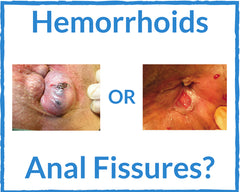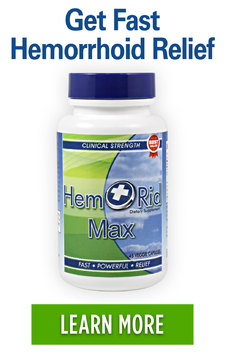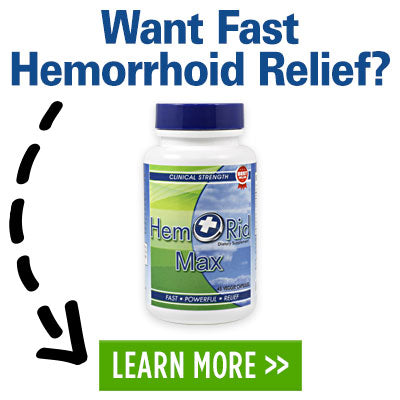Hemorrhoid Fissure Guide - The Difference Between Hemorrhoids and Fissures
Posted on 10 May 2018 by Maryanne Johnson
Share this post
In this Hemorrhoid Fissure guide, we will discuss the differences between hemorrhoids and fissures so that you know exactly which one you have. Plus, we talk about the best treatment options for both fissures and hemorrhoids.
Table of Contents [hide]
- 1. Introduction
- 2. Do I Have Hemorrhoids or an Anal Fissure?
- 3. Hemorrhoid Fissure Treatment
- 4. How to Get Hemorrhoid Fissure Relief
- 5. Is Hemorrhoid Fissure Surgery Worth It?
- 6. Hemorrhoids and Fissures Together
- 7. Pain Relief for Hemorrhoids and Fissures
- 8. Home Treatment for Hemorrhoids and Fissures
- 9. Hemorrhoids or Fissure Symptoms
- 10. Conclusion
Introduction
You'll leave this post with a solid understand of the two and be armed with tools to get lasting relief.
Hemorrhoids are veins inside and around your anus and rectal area. These veins are responsible for promoting healthy circulation of blood vessels to this vital part of your body.
As we age, hemorrhoid symptoms become increasingly prevalent, and many researchers think this is because specific muscles and lining weaken in the area that holds these veins in place.
Nearly half of Americans ages 50 and older have hemorrhoid symptoms.
Symptoms brought on by inflamed and swollen hemorrhoids include bleeding, discomfort, itching and irritation, and pain.
External hemorrhoids typically bring about the worst of these symptoms, as they are located beneath the skin around the outside of the anus.
Often, anal fissures go hand in hand with hemorrhoids, as the primary cause of both is constipation and the straining during a hard-to-pass bowel movement.
Anal fissures are small tears in the skin around the anal region. The side effects of anal fissures can mimic those of hemorrhoids.
These small tears are almost like paper cuts and can cause itching and bleeding. In some cases, anal fissures can be more painful than hemorrhoids.
Youtube VideoDo I Have Hemorrhoids or a Fissure?
While symptoms are similar—the itching, bleeding and general discomfort, hemorrhoids and anal fissures are entirely different causes that perpetuate these side effects.
Anus Fissure vs Hemorrhoid
Hemorrhoids, or piles, are the inflamed veins, whereas anal fissures are small tears of the lining or skin in and around the anus.
Hemorrhoids may cause fissures to form, as the difficulty of passing a hard stool can tear the lining, resulting in a fissure.
The best way to know which one you may have is to know the difference between the two.
Internal hemorrhoids are undetectable, but you may see blood covering your stool or when you wipe.
External hemorrhoids are small bumps outside of the anal area, as they are the swollen veins beneath the skin.
Fissures are tears, and while you will notice discomfort and bleeding if you don’t feel bumps to go along with these symptoms, chances are you likely have an anal fissure.
We hope you can now figure out if you have an anal fissure or hemorrhoid. If you still have questions, read on to learn more about your treatment options for both.
Hemorrhoid Fissure Treatment
If you think you may have both, which is entirely possible as hemorrhoid straining can often result in a fissure, there are treatment options you can try at home.
- Stool softener: Softening your stools will help with your bowel movements and decrease the likelihood of creating more fissures, irritating your swollen hemorrhoids, and causing more irritation against newly formed fissures.
- Fiber: Including high fiber foods in your diet will help immensely with hemorrhoid fissures. A fibrous diet will keep your colon regular and keep the stools soft and easier to pass. If you cannot include fibrous foods in your diet, then try supplements. Many fiber supplements have no taste to them and can be easily added in beverages and meals.
- Water: Keeping hydrated is an essential part of treating and preventing hemorrhoid fissures. Drinking plenty of water throughout the day will allow your stools to retain this moisture, making them softer and preventing straining during a bowel movement. Staying hydrated also flushes the toxins out of your body and promotes the proper functioning of your internal organs.
How to Get Hemorrhoid Fissure Relief
Hemorrhoid fissures can be incredibly painful, especially during a bowel movement that requires straining to pass.
The feelings of pain and discomfort can even last hours after a difficult bowel movement.
It can be frustrating to experience these symptoms every time you use the bathroom, but fortunately, there are plenty of ways to relieve the pain that you can even try in the comfort of your own home.
Methods to try for hemorrhoid fissure relief:
- Sitz bath: A sitz bath, or a bath where only the lower half of your body is submerged in water, is ideal for relieving pain from hemorrhoid fissures. Soak in a sitz bath with warm water for twenty minutes, once a day, or as needed.
- Wipes: Many people suffer from hemorrhoids and anal fissures and they often turn to the use of special wipes to alleviate the pain. Wipes with ingredients like witch hazel can reduce swelling and give you a soothing feeling of relief.
- Creams: Using creams like Preperation H or other over the counter topical ointments designed for hemorrhoid and fissure relief can promote and encourage healing. At the same time, apply creams offers immediate relief of painful symptoms.
Is Hemorrhoid Fissure Surgery Worth It?
Hemorrhoid fissures can be so painful and disrupt your life so much that you may need surgery.
One of the best surgeries for hemorrhoid fissures is called lateral internal sphincterotomy.
The goal of this surgery is to divide the internal layer to promote healing of anal fissures.
This surgery is invasive and can require a lot of pre and post-operative maintenance, like watching your diet, taking and not taking certain medications, and the recovery time can be anywhere from two to three weeks.
If your fissures do not heal on their own within a few days or weeks, or you are experiencing rectal bleeding more often than not, talk to your doctor to see if a hemorrhoid fissure surgery is worth it for you.
Hemorrhoids and Fissures Together
As if hemorrhoids were not enough to make life uncomfortable, anal fissures can occur at the same time. Where hemorrhoids are swollen clusters of blood vessels that can form inside the rectum or outside the anus, fissures tend to develop on the anal opening or the lining inside the anal canal.
While you cannot feel internal hemorrhoids unless they prolapse, you can quickly tell the difference between an anal fissure and external hemorrhoids.
Anal fissures feel like paper cuts, and when visibly examined, look like small tears. External hemorrhoids are flesh-colored bumps that cause itching and pain.
Both conditions are common, nearly half of adults over the age of 50 have hemorrhoids, and there are over 200,000 cases per year of anal fissures, and there is a high probability they occur together due to both resulting from constipation and hard stools.
Pain Relief for Hemorrhoids and Fissures
Having both hemorrhoids and fissures is a painful experience. Luckily, in time, both of these issues resolve themselves, but what can you do in the meantime?
Here are a few things you can try to relieve the pain:
- Sitz bath: a warm sitz bath for fifteen to twenty minutes can instantly reduce the pain of anal fissures and external hemorrhoids.
- Pain medication: you shouldn’t suffer without the aid of over the counter pain medication, which can target symptoms of discomfort and swelling.
- Creams: there are plenty of hemorrhoid creams on the market that with direct application, can sooth fissures and hemorrhoids while even reducing inflammation.
Using these methods for quick relief of pain can also encourage speedier healing of external hemorrhoids and anal fissures. Remember to be careful while wiping as not to make symptoms worse.
Home Treatment for Hemorrhoids and Fissures
Having hemorrhoids and fissures together can make a trip to the bathroom ten times longer and nightmarish.
Fortunately, there are home treatments you can try to encourage these issues to resolve themselves faster while also alleviating the painful symptoms.
- Warm bath: Soak in a warm tub for at least ten to fifteen minutes. You don't need to add anything to the water unless you prefer to. The warm water will ease inflammation and encourage a quicker recovery time.
- Stool softeners: You can purchase these at your local pharmacy. Stool softeners make for more comfortable to pass stools, which means less straining and pain for you during a bowel movement.
- Fiber: Fiber is an all-around beneficial asset to have to heal internal and external hemorrhoids and anal fissures. This nutrient curbs constipation, so the next bowel movement is much more comfortable to pass and less disruptive to these issues.
Hemorrhoids or Fissure Symptoms
While it can be trying at first to differentiate between an anal fissure and hemorrhoids, once you learn what sets these two rectal issues apart you will be able to decipher between the two.
Both fissures and external hemorrhoids can cause acute pain; however, fissures are small, paper-cut like tears in the anal lining, located either inside the anal canal or directly on the anus.
Symptoms of anal fissures are:
- Sharp, intense pain
- Bleeding
- Small lump or skin tag near fissure (more common with chronic fissures)
External hemorrhoids differ in shape, as they are clusters of swollen, flesh-colored blood vessels that form around the anal opening.
External hemorrhoids may develop blood clots and turn a blue or purple color. To the touch, external hemorrhoids can feel rubbery and bumpy.
Symptoms of external hemorrhoids are:
- Itching
- Burning
- Pain
- Discomfort while sitting, standing, or during bowel movements
Conclusion
Regardless of whether or not you have hemorrhoids or fissures, be sure to let your doctor know the full scope of what you are experiencing.
Symptoms of rectal bleeding might require an examination by your doctor, as it could be an indication of a condition that is not hemorrhoids or fissures.






0 comments